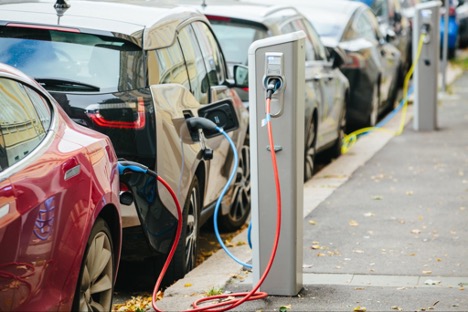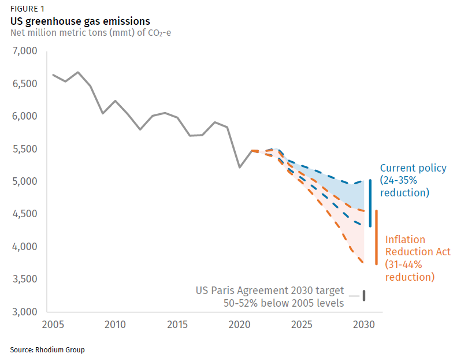An Interview with BV Operating Partner and Governor Bill Ritter: What the IRA and CHIPS Act mean for climate change and the economy?
“The most massive public dollar investment we’ll probably see in our lifetime.”
With this week’s passage of the $369B Inflation Reduction Act, and the passage earlier this month of the $52B CHIPS Act, we’ve been getting inbound questions as to how these new policies impact our investment thesis, and underlying portfolio companies. With unprecedented investments in industrial capacity, manufacturing, clean energy infrastructure and workforce development, these two pieces of policy are shifting the course of our economy: long term, transparent price signals for renewable energy, and historic investments and tax incentives for the electrification of transportation and housing.
For some perspective on how this legislation will impact Blackhorn portfolio companies, and what it means for how Blackhorn approaches opportunities in resource efficiency and digital infrastructure, we turned to Blackhorn Operating Partner Bill Ritter. Should you have additional questions on what these new rules mean for your organization or for our investment approach, please reach out. We look forward to hearing from you!
During his four-year term as Governor of Colorado (2006-2010), Bill Ritter established Colorado as a national and international clean energy leader by building a New Energy Economy. After leaving the Governor’s Office, Ritter founded the Center for the New Energy Economy at Colorado State University, which works with state and federal policymakers to create clean energy policy throughout the country. Governor Ritter has authored a book that was published in 2016 entitled, Powering Forward – What Everyone Should Know About America’s Energy Revolution. Governor Ritter was formerly the chair of the Board of Directors of the Energy Foundation and currently serves on the board of The Climate Group American and the Board of Trustees of The Nature Conservancy. The following interview has been edited for brevity.
What does the IRA mean for our core investment thesis as far as industrial decarbonization and resource efficiency?
We look at the sectors that are most in need of decarbonization, and these are the same sectors we’re working in – the power sector, the transportation sector, the built environment and our supply chain. The Inflation Reduction Act actually covers all of those sectors as part of decarbonizing the economy and simultaneously growing the economy and reducing inflation. So if you look at the act, it has a variety of ways of addressing each of those. Some things it addresses with tax credits, and that’s going to spur investment in those areas. Some things it addresses with formula grants or other kinds of grant programs. The thought is that it will spur investment, by providing federal investments for industries that require a big capital outlay. It will cause us to develop platforms to manage the intersections between our supply chain, the built environment, the transportation sector and the power sector.
Is there one specific policy lever or section of the bill that you think is going to have the largest impact on reducing emissions?
We have seen the use of the investment tax credit and the production tax credits for a significant amount of investment in solar, in storage, and in wind. And we were also seeing those tax credits being tamped down or going away altogether over the next few years. This is going to reinvigorate the clean energy economy. We are going to see significant investments in wind, storage and solar that we might not have seen had the act not passed. It also has a significant ambition toward creating American jobs. It’s fair to say that in particular where solar and batteries are concerned, we lost out to the Chinese over the last decade. This act makes a significant move toward our being able to reclaim a leadership role in the manufacturing sectors that are going to be part of the energy transition economy.

(Credit: Nicole Kelner)
How should Limited Partners be thinking about the tailwinds that this federal policy creates?
Don’t look at the Inflation Reduction Act just in isolation. Look at it also in combination with the Bipartisan Infrastructure Law. Those two taken together are massive investments in the American economy, in places where we badly need those investments. The Infrastructure Act had many parts to it that were favorable for decarbonization, towards clean transportation and things of that nature. And certainly this act does as well. And so limited partners should be looking at this as the most massive public dollar investment we’ll probably see in our lifetime. It is really about trying to spur this transition to a clean energy economy. And it starts with the public investment, but fits our thesis that this is the place we most need to be to make the impact we need to make regarding decarbonization.

(Image courtesy of Blackhorn Ventures)
Do you see this bill changing Blackhorn’s investment strategy, either for the short or the long term?
I don’t think so. That’s the interesting thing for me – this is the transition that we believed needed to happen. These are the sectors that need to be decarbonized. Our thesis is about the fact that we will have an impact by investing in those companies that are going to manage this energy transition. We are going to invest in companies that say, for example, “This is a massive transition for utilities. How can we do that and do it smoothly?” We have an opportunity to modernize the grid in a way that has both sides of the meter talking to each other, and helping grid managers ensure that they’re living up to all their ambitions with respect to their renewable energy goals and their emissions reduction goals. There’s a great deal of grid modernization that has to go on. We’re investing in companies that are going to facilitate that. And the same goes with the built environment. The built environment is 40% of our emissions, and we really are going to get to the kind of emissions reductions that we promised as part of our participation in the Paris Accords. If we’re going to do that, we have to impact the built environment in a positive way. And so that’s going to be people thinking about building materials, but it’s also going to be people who understand that managing the activities in a building site, or managing the meter inside of a building, or rethinking how you plan to increase the efficiency of the building, is all part of a decarbonized economy .
Is there a particular sector of technology that you think will see a particularly significant uptick thanks to the IRA?
I think we were already at a place where we were going to experience a fairly precipitous change in the electric vehicle market. You can see it building– it felt like we were coming to a tipping point. I think the Inflation Reduction Act provides the tipping point for that. With the level of tax credits that are available both for new and used electric vehicles, I think we’re gonna see something fairly dramatic. And I believe that’s true not just in the light duty vehicle market, but in the medium size and heavy duty as well.

(Image courtesy of Blackhorn Ventures)
What advice do you have for startups in this space seeking to navigate the IRA and take advantage of the funding coming down the pipe?
Well, startups shouldn’t bend their vision around the Inflation Reduction Act. They should actually ensure that they have a fundamentally sound solution that can be commercialized. It’s not hurtful to have these kinds of public dollars available. But I hope that founders don’t believe that they should try to mold their concept to what the Inflation Reduction Act says, because anytime you have a space like this, you’re using kind of a blunt instrument. I mean, a tax credit is a fairly blunt instrument. And so if I’m a founder, and I have a startup, and I’ve got a new solution, my funding is going to probably start out in a way that’s relatively typical for venture capital funding, and over time, it might be able to take advantage of some byproduct of the Inflation Reduction Act, but probably not in the first instance.
Would you be able to give us a bullish and a bearish scenario for how the IRA affects us?
The bullish side is, I think that because this act covers the sectors that we care about most, because it’s about decarbonization, it fits hand in glove with our narrative. And so, if everything were to go perfectly, this could make just a tremendous difference in our ability to address climate change in the short term, and have a tremendous positive impact on our portfolio companies and the companies we will invest in over the next year or two, because our thesis remains about these sectors. The bearish part of this is that this is all really big. It comes on the heels of the Bipartisan Infrastructure Law, and it requires the federal government to do a great deal that it’s not to date capable of doing. New offices have to be stood up – for the infrastructure act alone, the Department of Energy had to stand up 30 new offices to manage the dollars that are going out the door. And so it’s not to fault the federal government. It’s just that the two came together very quickly. I think it would be fair to say that today, as the Act has just passed, we don’t have either the personnel nor the organizations within federal agencies to get this out the door. Now, we have to build that. the bearish scenario is that we don’t build it right. It takes longer to get out the door. There’s a lag time that impacts investors in a negative way because the returns come later down the road, but it also takes up precious time with addressing environmental issues including climate change. So the most bearish thing, the biggest concern I have about this is whether the federal government is fully equipped to do what’s necessary to make this money as impactful as it needs to be both from an economic perspective in reducing inflation and growing the economy, growing American jobs, but also in a climate/ environmental perspective, and addressing carbon in a timely fashion.

(Credit: Rocky Mountain Institute)
With the recent passage of the CHIPS Act, it seems like America has embraced some bipartisan action regarding industrial policy. Could you speak to the effect of the CHIPS Act, and the importance of good industrial policy in general?
People who feel we lost our leadership role as a manufacturing economy were in part right about that. I think we still manufacture a lot of things in America, our manufacturing economy has played such a significant role in our economic well being. But we’ve also not done as well where things like chips are concerned, in maintaining our lead in high tech manufacturing. Other countries have done well in that – it’s not like we’ve forfeited our position completely, but I think the CHIPS Act is going to allow us to reestablish our leadership position. That’s important for a couple of reasons. Obviously, it helps grow the economy, we’re becoming more and more of a software driven economy. But in addition to that, it would appear that the legislation is going to incentivize jobs to stay on shore. And finally, it hopefully resolves a problem where the supply chain is concerned, because I think there were a lot of different issues around supply chains and chips, and this hopefully will impact our ability to have chips available, and not have to rely on other foreign countries to provide them for us.

(Image courtesy of Blackhorn Ventures)
You’ve been around the block as far as climate legislation is concerned. What is it specifically that makes this time truly historic?
I’d say the first thing is the amount of investment that is involved. When I was Governor of Colorado, we went through the Great Recession, and we had the American Recovery and Reinvestment Act. And the total amount of investment in clean energy was $90 billion. And President Obama was very much a person who believed that we needed to address climate change and clean energy. This time, first of all, it’s 14 years later. The issues that impact us related to climate and the environment are significantly more pronounced than they were 14 years ago. People who are looking at the clock and thinking about the window we have to address this have shortened the timeframe within which we have to act. So there’s far more money, but that money is tied to the urgency that we have to act. It’s also concentrated in places where we’re pretty confident it’s going to cause people to invest at a deeper level on the private side and help us to make that transition from a carbonized economy to a decarbonized one.
I’d like to add that this bill really does more from an environmental justice perspective than any piece of legislation that I can ever remember. The kinds of ways it incentivizes to build out energy efficiency and low income neighborhoods, the things that does to ensure that power delivered to low income neighborhoods is clean power, is remarkable. There are a variety of incentives for transportation to be carbon free, and that transportation be available to low income people and people who live in marginalized communities. This legislation does more than any other thing I’ve ever seen in that regard. And that is also how we should think about our energy economy in transition, that this time, we should leave no one behind.

Is there anything else that you think is important to keep in mind as we’re going forward?
The IRA is being called a climate bill– but there’s nothing in the bill that puts a limit on emissions. There’s nothing that requires a reduction of emissions. Nothing like a clean energy standard, or when there was the Clean Power Plan. Prior legislation had that, this legislation does not. So, you know, we really have to work very hard at ensuring that the incentives work, that American consumers and American workers are fully participating in this and that the parts of this that are about environmental justice also are being fully executed. I think it’s incumbent upon all of us to do that and not just rely on this as legislation that was passed and will now address climate. It actually doesn’t do that without full participation of the American worker, the American consumer.